A friend of mine is a teacher at a school where the theme next year is “Reading Is My Superpower.” I don’t know if I necessarily agree that reading is a superpower so much as that reading gives me superpowers, but perhaps that’s just semantics. 🙂 I had also forgotten that the Milwaukee Public Library theme last summer and this one is Super Readers, and I stumbled across the display at my local branch and filled up my library bag with some of their suggestions, too. So, if your summer isn’t saturated enough by Marvel’s superheroes (and I will include some of them, just to give you fair warning!), your young readers will have a chance to explore what makes a hero super! (Weird fast fact: My family was playing the board game Life a couple of days ago, and one of the action cards called for the kids to state their superpowers. GirlChild said strength, speed, and wisdom. BoyChild said punching people in the face. Oy. That child.)
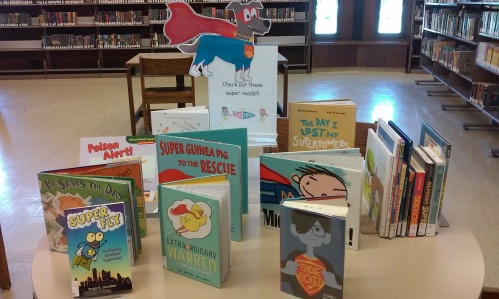
The Super Reader summer reading display at the Mill Road branch of the Milwaukee Public Library (before I pillaged it).
 Superhero Me!, by Karen Katz (2009, toddler to preschool): Karen Katz appears to have a board book for nearly every occasion! Her typical round-faced, happy toddlers try out different superhero identities, from Super Rexosaur to Puddle-Jumper, in this rhyming touch-and-feel book. My children have always loved these simple, bright books and are drawn to them in the board book section of the library with regularity even now! This is a perfect first introduction to the idea of superhero play for little ones!
Superhero Me!, by Karen Katz (2009, toddler to preschool): Karen Katz appears to have a board book for nearly every occasion! Her typical round-faced, happy toddlers try out different superhero identities, from Super Rexosaur to Puddle-Jumper, in this rhyming touch-and-feel book. My children have always loved these simple, bright books and are drawn to them in the board book section of the library with regularity even now! This is a perfect first introduction to the idea of superhero play for little ones!
Super Duck, by Jez Alborough  (2009, toddler to preschool): Like all his other Duck books, this Alborough installment features the very eager duck, several somewhat exasperated barnyard friends, and a lot of rhyming! When Sheep, Goat, and Frog are trying to fly a kite, Duck proclaims that he is Super Duck and tries his best to help (with mixed results). When Frog gets swept away with the kite, Duck actually comes to the rescue and gets him safely back to the ground. Sheep and Goat are so happy that they call him Super Duck, too!
(2009, toddler to preschool): Like all his other Duck books, this Alborough installment features the very eager duck, several somewhat exasperated barnyard friends, and a lot of rhyming! When Sheep, Goat, and Frog are trying to fly a kite, Duck proclaims that he is Super Duck and tries his best to help (with mixed results). When Frog gets swept away with the kite, Duck actually comes to the rescue and gets him safely back to the ground. Sheep and Goat are so happy that they call him Super Duck, too!
 Do Super Heroes Have Teddy Bears?, by Carmela LaVigna Coyle, illustrated by Mike Gordon (2012, preschool to early elementary): This picture book asks questions (“Do super heroes make capes with blankies and string?”) followed by italicized answers (“We can turn blankies into most anything.“) Judging by the illustrations (and I didn’t quite get it at first), members of a family are asking questions of one another about super heroes (based on the daily activities the self-styled super hero brother and (potentially) sidekick little sister). Many of the questions are from little sister to older brother and some are the kids to their parents. (A helpful comprehension activity might be to work with your little listener to figure out who the speakers are on each spread.) I have definitely had these kinds of conversations going on randomly throughout the day at my house (topic based on whatever long-term role-play my kids are currently into), so once you get the hang of the abruptly changing speaker concept, this story is pretty representative of real kids doing what they do best–imagining!
Do Super Heroes Have Teddy Bears?, by Carmela LaVigna Coyle, illustrated by Mike Gordon (2012, preschool to early elementary): This picture book asks questions (“Do super heroes make capes with blankies and string?”) followed by italicized answers (“We can turn blankies into most anything.“) Judging by the illustrations (and I didn’t quite get it at first), members of a family are asking questions of one another about super heroes (based on the daily activities the self-styled super hero brother and (potentially) sidekick little sister). Many of the questions are from little sister to older brother and some are the kids to their parents. (A helpful comprehension activity might be to work with your little listener to figure out who the speakers are on each spread.) I have definitely had these kinds of conversations going on randomly throughout the day at my house (topic based on whatever long-term role-play my kids are currently into), so once you get the hang of the abruptly changing speaker concept, this story is pretty representative of real kids doing what they do best–imagining!
Superhero School,  by Thierry Robberecht and Philippe Goossens (2011, preschool to early elementary): You can kind of tell that this book is a translation (from Dutch, if anyone’s interested) because it just feels a little off in the cadence and phrasing. Still, my kids enjoyed the storyline! Henry (who wears headgear that suggests a jester’s cap) attends superhero school, but he is kind of the class clown and struggles with his superhero studies. He can’t fly, isn’t super strong, and believes pranks to be his only superpower. When a horrible monster comes to the school, Henry’s classmates are quickly neutralized, but Henry’s quick-thinking prank catches the monster off-guard, and his tickles drain the monster’s strength. The others step back in and ship the monster back to the planet he came from, but Henry is celebrated for saving the day!
by Thierry Robberecht and Philippe Goossens (2011, preschool to early elementary): You can kind of tell that this book is a translation (from Dutch, if anyone’s interested) because it just feels a little off in the cadence and phrasing. Still, my kids enjoyed the storyline! Henry (who wears headgear that suggests a jester’s cap) attends superhero school, but he is kind of the class clown and struggles with his superhero studies. He can’t fly, isn’t super strong, and believes pranks to be his only superpower. When a horrible monster comes to the school, Henry’s classmates are quickly neutralized, but Henry’s quick-thinking prank catches the monster off-guard, and his tickles drain the monster’s strength. The others step back in and ship the monster back to the planet he came from, but Henry is celebrated for saving the day!
 These Are the Avengers, adapted by Thomas Macri (2012, preschool to early elementary): This early reader book introduces the six Mighty Avengers: Captain America, Ant-Man, Wasp, the Hulk, Thor, and Iron Man. (So, you know, not the cinematic universe version of the Avengers.) The book gives the basic information about the six characters in short, easy to read sentences. (BoyChild enjoys this as a quick read-aloud, but a budding reader with some knowledge about Marvel characters could handle it as a simple text for independent reading.) There are a number more of these books available, and there are games and other activities available on the Marvel Kids website as well. You can compare the different levels and types of books available about Marvel characters by checking out This Is Thor (World of Reading: Level 1, preschool to early elementary), Heroes of Asgard (World of Reading: Level 2, early elementary), and Marvel Adventures: The Avengers: Thor (a graphic novel, middle school to high school).
These Are the Avengers, adapted by Thomas Macri (2012, preschool to early elementary): This early reader book introduces the six Mighty Avengers: Captain America, Ant-Man, Wasp, the Hulk, Thor, and Iron Man. (So, you know, not the cinematic universe version of the Avengers.) The book gives the basic information about the six characters in short, easy to read sentences. (BoyChild enjoys this as a quick read-aloud, but a budding reader with some knowledge about Marvel characters could handle it as a simple text for independent reading.) There are a number more of these books available, and there are games and other activities available on the Marvel Kids website as well. You can compare the different levels and types of books available about Marvel characters by checking out This Is Thor (World of Reading: Level 1, preschool to early elementary), Heroes of Asgard (World of Reading: Level 2, early elementary), and Marvel Adventures: The Avengers: Thor (a graphic novel, middle school to high school).
Ten Rules of Being a Superhero,  by Deb Pilutti (2014, preschool to early elementary): A young boy and his superhero action figure present the ten rules of being a superhero. (The action figure appears to be living in each scenario, but he is toy-sized and sometimes his movement is controlled by the boy, so I’m assuming all life-like qualities are just the boy’s imagination shown as reality.) My favorite rules are Rule Number 1: “A superhero must ALWAYS respond to a call for help…even if the odds are against him” (and showing a number of other toys in dire situations that need to be rescued) and Rule Number 4: “A superhero must use his power in a good way” (as opposed to the selfish villain thinking about using his powers in a bad way). The last rule, Rule Number 10, is also a good one: “Every superhero needs a sidekick. Because saving the day is more fun with a friend.”
by Deb Pilutti (2014, preschool to early elementary): A young boy and his superhero action figure present the ten rules of being a superhero. (The action figure appears to be living in each scenario, but he is toy-sized and sometimes his movement is controlled by the boy, so I’m assuming all life-like qualities are just the boy’s imagination shown as reality.) My favorite rules are Rule Number 1: “A superhero must ALWAYS respond to a call for help…even if the odds are against him” (and showing a number of other toys in dire situations that need to be rescued) and Rule Number 4: “A superhero must use his power in a good way” (as opposed to the selfish villain thinking about using his powers in a bad way). The last rule, Rule Number 10, is also a good one: “Every superhero needs a sidekick. Because saving the day is more fun with a friend.”
 The Day I Lost My Superpowers, by Michaël Escoffier and Kris Di Giacomo (2014, preschool to early elementary): A small child discovers one day (with the help of her father’s hands tossing her in the air) that she can fly! She realizes she has a variety of other powers, too…like making things disappear (although that works better with cupcakes than with peas) and becoming invisible herself (with the help of the underside of her bed). One day, however, she falls when “flying” (with the help of her dog and a string), and she realizes she has lost her superpowers (and hurt her knee)! Her mom comes to the rescue, however, with a magic kiss that makes her feel “all better (even if [her] knee still hurt[s] a little),” and she is excited to realize that her mom might have superpowers, too! The illustrations help tell the story by revealing the reality behind her superpower statements, and they help young readers and listeners feel like they’re in on the joke (as well as give them good ideas for superhero play of their own).
The Day I Lost My Superpowers, by Michaël Escoffier and Kris Di Giacomo (2014, preschool to early elementary): A small child discovers one day (with the help of her father’s hands tossing her in the air) that she can fly! She realizes she has a variety of other powers, too…like making things disappear (although that works better with cupcakes than with peas) and becoming invisible herself (with the help of the underside of her bed). One day, however, she falls when “flying” (with the help of her dog and a string), and she realizes she has lost her superpowers (and hurt her knee)! Her mom comes to the rescue, however, with a magic kiss that makes her feel “all better (even if [her] knee still hurt[s] a little),” and she is excited to realize that her mom might have superpowers, too! The illustrations help tell the story by revealing the reality behind her superpower statements, and they help young readers and listeners feel like they’re in on the joke (as well as give them good ideas for superhero play of their own).
SuperHero ABC,  by Bob McLeod (2006, preschool to early elementary): While a typical alphabet book has a limited audience (based on those who are still getting comfortable with the alphabet), the contents of this book will bring in a greater range of readers (and will make some parents shy away!). Twenty-six superheroes (or superhero groups) represent the letters of the alphabet, and some of the powers get downright gross (like Goo Girl (who “shoots gobs of goo at gangsters”) and The Volcano (who “vomits on villains”)) and the characteristics silly (Upside-Down Man “wears his uniform under his underwear” and Astro-Man has asthma (?!)) as the real-life-comic-book-artist author puts as many of the featured letter onto the pages as possible. My only gripe with the book is that, although the general public depicted in the art is reasonably diverse, the vast majority of the featured heroes/heroines (and there are a decent number of females) are pretty pale (with just a couple exceptions…and a few aliens).
by Bob McLeod (2006, preschool to early elementary): While a typical alphabet book has a limited audience (based on those who are still getting comfortable with the alphabet), the contents of this book will bring in a greater range of readers (and will make some parents shy away!). Twenty-six superheroes (or superhero groups) represent the letters of the alphabet, and some of the powers get downright gross (like Goo Girl (who “shoots gobs of goo at gangsters”) and The Volcano (who “vomits on villains”)) and the characteristics silly (Upside-Down Man “wears his uniform under his underwear” and Astro-Man has asthma (?!)) as the real-life-comic-book-artist author puts as many of the featured letter onto the pages as possible. My only gripe with the book is that, although the general public depicted in the art is reasonably diverse, the vast majority of the featured heroes/heroines (and there are a decent number of females) are pretty pale (with just a couple exceptions…and a few aliens).
 Dex: The Heart of a Hero, by Caralyn Buehner, illustrated by Mark Buehner (2004, preschool to early elementary): Dexter is a dachshund dog (living in a world populated by anthropomorphic dogs, cats, and rodents) who dreams big dreams. (The ultra-dramatic superhero-esque thoughts are written in comic book handwritten style in yellow text boxes.) He is very ordinary and very small, but he decides that if he wants to be a hero, he needs to make himself one! He begins training by exercising to get strong, climbing trash piles to gain endurance, and pushing himself those extra few circles before lying down to sleep. When his efforts pay off, he completes his transformation with a mail-order costume. His heroic acts are all pretty mild but satisfying–helping a puppy cross the street, finding a lost kitten, and organizing a neighborhood clean-up day–until the night that Cleevis the tomcat finds himself in a precarious situation high in a tree. Dex uses his wits and the resources around him (in this case, a teeter-totter and a crowd of onlookers) to save Cleevis and win his respect…and a partner in crime-fighting!
Dex: The Heart of a Hero, by Caralyn Buehner, illustrated by Mark Buehner (2004, preschool to early elementary): Dexter is a dachshund dog (living in a world populated by anthropomorphic dogs, cats, and rodents) who dreams big dreams. (The ultra-dramatic superhero-esque thoughts are written in comic book handwritten style in yellow text boxes.) He is very ordinary and very small, but he decides that if he wants to be a hero, he needs to make himself one! He begins training by exercising to get strong, climbing trash piles to gain endurance, and pushing himself those extra few circles before lying down to sleep. When his efforts pay off, he completes his transformation with a mail-order costume. His heroic acts are all pretty mild but satisfying–helping a puppy cross the street, finding a lost kitten, and organizing a neighborhood clean-up day–until the night that Cleevis the tomcat finds himself in a precarious situation high in a tree. Dex uses his wits and the resources around him (in this case, a teeter-totter and a crowd of onlookers) to save Cleevis and win his respect…and a partner in crime-fighting!
Superhero,  by Marc Tauss (2005, preschool to early elementary): All in black-and-white enhanced photographs, the story starts in the front endpapers with Maleek (the main character, a young boy) browsing an aisle full of different comic books. (Maleek likes to “catch up on his fellow superheroes’ adventures.”) Maleek wears a costume with goggles and a cape with a large M on it, and he builds inventions in his laboratory. When he reads in the newspaper one day that all the city parks and playgrounds have disappeared (replaced by tall buildings), he and his robot jump into their time machine and go back 500 years to collect plant specimens that he uses to create GIGUNDO JUICE. He sprays his concoction all over the city, and large, beautiful plants spring up to replace many of the big buildings. His work complete, Maleek goes back to his comics again. The last page shows him reading a comic book and with other props around him that appear to have contributed to the superhero daydream he seems to have been having, and the final endpapers show Maleek in full costume wandering the same aisle…which is now full of comics about himself.
by Marc Tauss (2005, preschool to early elementary): All in black-and-white enhanced photographs, the story starts in the front endpapers with Maleek (the main character, a young boy) browsing an aisle full of different comic books. (Maleek likes to “catch up on his fellow superheroes’ adventures.”) Maleek wears a costume with goggles and a cape with a large M on it, and he builds inventions in his laboratory. When he reads in the newspaper one day that all the city parks and playgrounds have disappeared (replaced by tall buildings), he and his robot jump into their time machine and go back 500 years to collect plant specimens that he uses to create GIGUNDO JUICE. He sprays his concoction all over the city, and large, beautiful plants spring up to replace many of the big buildings. His work complete, Maleek goes back to his comics again. The last page shows him reading a comic book and with other props around him that appear to have contributed to the superhero daydream he seems to have been having, and the final endpapers show Maleek in full costume wandering the same aisle…which is now full of comics about himself.
 Eliot Jones, Midnight Superhero, by Anne Cottringer, illustrated by Alex T. Smith (2008, preschool to early elementary): Eliot is a quiet boy who spends his days doing quiet things. Once the clock strikes midnight, however, he is a superhero. He answers the call of everyone from the Coast Guard to the queen, and his skills and powers are always up to the task at hand! His mission tonight involves saving the world from a rogue meteor, and he blasts it just in time. At the end of the story, we are back to the beginning, in Eliot’s quiet room, and we are told that “being a Midnight Superhero is very tiring. It doesn’t leave Eliot with much energy. So by day…Eliot is quiet.” This is a cute story that might leave kids wondering what secrets lurk behind the commonplace faces they see every day!
Eliot Jones, Midnight Superhero, by Anne Cottringer, illustrated by Alex T. Smith (2008, preschool to early elementary): Eliot is a quiet boy who spends his days doing quiet things. Once the clock strikes midnight, however, he is a superhero. He answers the call of everyone from the Coast Guard to the queen, and his skills and powers are always up to the task at hand! His mission tonight involves saving the world from a rogue meteor, and he blasts it just in time. At the end of the story, we are back to the beginning, in Eliot’s quiet room, and we are told that “being a Midnight Superhero is very tiring. It doesn’t leave Eliot with much energy. So by day…Eliot is quiet.” This is a cute story that might leave kids wondering what secrets lurk behind the commonplace faces they see every day!
Wonder Woman: The Story of the Amazon Princess,  written and illustrated by Ralph Cosentino (2011, early elementary): This almost-picture-book graphic novel is written in first person as Wonder Woman explains her origins, her powers, and how she came to be Wonder Woman. It even introduces many of her chief antagonists, like Cheetah and Ares, and states her mission: “to teach peace and respect to all…and to show the world how to live in harmony with nature.” Some companion books to this one are Batman: The Story of the Dark Knight and Superman: The Story of the Man of Steel. These books are a simple way to introduce your young readers to the most famous DC superheroes!
written and illustrated by Ralph Cosentino (2011, early elementary): This almost-picture-book graphic novel is written in first person as Wonder Woman explains her origins, her powers, and how she came to be Wonder Woman. It even introduces many of her chief antagonists, like Cheetah and Ares, and states her mission: “to teach peace and respect to all…and to show the world how to live in harmony with nature.” Some companion books to this one are Batman: The Story of the Dark Knight and Superman: The Story of the Man of Steel. These books are a simple way to introduce your young readers to the most famous DC superheroes!
Buzz Boy and Fly Guy,  by Tedd Arnold (2010, early elementary): In this book from the Fly Guy series, Buzz writes a book that stars him and Fly Guy as superheroes! Buzz (Buzz Boy!) is the same size as Fly Guy, and Fly Guy can talk! They use their wits and their superpowers to defeat wicked pirates, befriend a dragon, and return home safely. A great first chapter book (which is mostly a simple graphic novel divided into chapters) for young readers, parents or teachers might (subtly, so as not to spook an inspired reader into thinking it’s a homework assignment!) suggest that the reader write a comic book about himself or herself as a superhero with an animal sidekick.
by Tedd Arnold (2010, early elementary): In this book from the Fly Guy series, Buzz writes a book that stars him and Fly Guy as superheroes! Buzz (Buzz Boy!) is the same size as Fly Guy, and Fly Guy can talk! They use their wits and their superpowers to defeat wicked pirates, befriend a dragon, and return home safely. A great first chapter book (which is mostly a simple graphic novel divided into chapters) for young readers, parents or teachers might (subtly, so as not to spook an inspired reader into thinking it’s a homework assignment!) suggest that the reader write a comic book about himself or herself as a superhero with an animal sidekick.
Fireboy to the Rescue: A Fire Sa fety Book, by Edward Miller (2010, early elementary): As the title suggests, this is more a fire safety book than a superhero story. Fireboy is a narrator of sorts, telling about the good and bad things about fire. Although he is the title character, the book sticks to facts about fire safety, including what you should do in case of a fire (from calling 911 to how to evacuate a home, high-rise building, and school), how firefighters respond, and how to prevent fires. This book serves as a PSA about fire for young readers, and both GirlChild and BoyChild loved it as much as if it had an actual storyline! (GirlChild is really into fire safety anyway because of school, and BoyChild has asked several times (possibly because he heard GirlChild ask, partly because it sounds cool) about the fire escape ladders we’re going to have to buy when we move into a two-story home this summer! The author has written a couple other health and safety books that I’m sure my children would love as well!)
fety Book, by Edward Miller (2010, early elementary): As the title suggests, this is more a fire safety book than a superhero story. Fireboy is a narrator of sorts, telling about the good and bad things about fire. Although he is the title character, the book sticks to facts about fire safety, including what you should do in case of a fire (from calling 911 to how to evacuate a home, high-rise building, and school), how firefighters respond, and how to prevent fires. This book serves as a PSA about fire for young readers, and both GirlChild and BoyChild loved it as much as if it had an actual storyline! (GirlChild is really into fire safety anyway because of school, and BoyChild has asked several times (possibly because he heard GirlChild ask, partly because it sounds cool) about the fire escape ladders we’re going to have to buy when we move into a two-story home this summer! The author has written a couple other health and safety books that I’m sure my children would love as well!)
Extraordinary Warren: A Super Chicken,  by Sarah Dillard (2014, middle elementary): Warren is a typical chicken, but he has grown tired of all the pecking and peeping and general blandness of his life on the farm. None of the other chickens agree, however, and he feels very alone. He happens upon a rat who is digging through the trash and bemoaning the lack of really good food…and he accidentally sets himself up to be on the rat’s menu! He (literally) bumps into an egg on his way home to tell the other chickens about the fact that someone considers him “Chicken Supreme,” and he tells the egg his story and that the egg can be his sidekick. When he leaves his unsuccessful flying lesson that day, he sees the rat with a cookbook and realizes the truth of what’s going on! In his attempts to convince the other chickens of the danger and to stop the rat’s plans, Warren has to rescue the egg, and it ends up hatching. Then Warren and his willing sidekick, Egg, set off together to continue to right wrongs and save the other chickens from the dangers that lurk nearby.
by Sarah Dillard (2014, middle elementary): Warren is a typical chicken, but he has grown tired of all the pecking and peeping and general blandness of his life on the farm. None of the other chickens agree, however, and he feels very alone. He happens upon a rat who is digging through the trash and bemoaning the lack of really good food…and he accidentally sets himself up to be on the rat’s menu! He (literally) bumps into an egg on his way home to tell the other chickens about the fact that someone considers him “Chicken Supreme,” and he tells the egg his story and that the egg can be his sidekick. When he leaves his unsuccessful flying lesson that day, he sees the rat with a cookbook and realizes the truth of what’s going on! In his attempts to convince the other chickens of the danger and to stop the rat’s plans, Warren has to rescue the egg, and it ends up hatching. Then Warren and his willing sidekick, Egg, set off together to continue to right wrongs and save the other chickens from the dangers that lurk nearby.
Zero the Hero,  by Joan Holub and Tom Lichtenheld (2012, elementary): Although this is technically a picture book (Joan Holub has an impressive list of both fiction and nonfiction children’s books for a range of ages, and Tom Lichtenheld is the illustrator of BoyChild’s favorite bedtime book (among many, many others)), the concepts explored range from the additive and commutative properties of addition to Roman numerals and place value, making the audience much wider. The fact that zero times anything is zero is vital to the climax of the story (as well as being part of the original conflict). Math teachers who like Math Curse or Sir Cumference and the First Round Table are likely to enjoy this book for their cross-curricular endeavors as well! (And I always have to plug Erin McEwan, Your Days Are Numbered, too–I used to read it to my fifth graders at the beginning of the year!)
by Joan Holub and Tom Lichtenheld (2012, elementary): Although this is technically a picture book (Joan Holub has an impressive list of both fiction and nonfiction children’s books for a range of ages, and Tom Lichtenheld is the illustrator of BoyChild’s favorite bedtime book (among many, many others)), the concepts explored range from the additive and commutative properties of addition to Roman numerals and place value, making the audience much wider. The fact that zero times anything is zero is vital to the climax of the story (as well as being part of the original conflict). Math teachers who like Math Curse or Sir Cumference and the First Round Table are likely to enjoy this book for their cross-curricular endeavors as well! (And I always have to plug Erin McEwan, Your Days Are Numbered, too–I used to read it to my fifth graders at the beginning of the year!)
 DC Super-Pets: Night of the Scaredy Crows, by Sarah Hines Stephens, illustrated by Art Baltazar (2012, elementary): In this series of books, the superheroes’ pets come to the rescue! And, not surprisingly, the villains’ pets are the cause of most of the problems. This particular book is about Ace the Bat-Hound and the troubles caused by Scarecrow’s pets/minions, Croward and the scaredy crows, as Halloween approaches. A Word Power page at the end of the book gives definitions and pronunciations for some of the more unusual words (like toxic and utility collar). There is quite a bit of text on each page, but there are frequent full-color illustrations to break it up. The text is larger than a typical chapter book but smaller than a picture book, and, at an approximate third-grade reading level, it could be a high-interest book for older kids who need a slightly simpler story that’s still interesting. (Marvel doesn’t have a monopoly on super-hero easy readers, either. The I Can Read series of books has several DC character stories, like Batman: Winter Wasteland (Level 2) and others on Amazon.)
DC Super-Pets: Night of the Scaredy Crows, by Sarah Hines Stephens, illustrated by Art Baltazar (2012, elementary): In this series of books, the superheroes’ pets come to the rescue! And, not surprisingly, the villains’ pets are the cause of most of the problems. This particular book is about Ace the Bat-Hound and the troubles caused by Scarecrow’s pets/minions, Croward and the scaredy crows, as Halloween approaches. A Word Power page at the end of the book gives definitions and pronunciations for some of the more unusual words (like toxic and utility collar). There is quite a bit of text on each page, but there are frequent full-color illustrations to break it up. The text is larger than a typical chapter book but smaller than a picture book, and, at an approximate third-grade reading level, it could be a high-interest book for older kids who need a slightly simpler story that’s still interesting. (Marvel doesn’t have a monopoly on super-hero easy readers, either. The I Can Read series of books has several DC character stories, like Batman: Winter Wasteland (Level 2) and others on Amazon.)
Captain Raptor and the Moon Mystery,  by Kevin O’Malley, illustrations by Patrick O’Brien (2005, elementary): I’m not sure this technically qualifies as a superhero story…but technologically advanced dinosaurs with space gadgets who fight off a beast who attacks a group of aliens (um, humans) and save the day (combined with the graphic novel format and typical superhero (well, like the old Batman show, at least) cliffhanger moments) certainly make Captain Raptor and his crew seem like superheroes! Jurassic Park meets Tony Stark meets Star Trek, maybe? Although this was shelved with the picture books, the graphic novel style and the realistic, detailed art make this more of a middle elementary and up kind of book.
by Kevin O’Malley, illustrations by Patrick O’Brien (2005, elementary): I’m not sure this technically qualifies as a superhero story…but technologically advanced dinosaurs with space gadgets who fight off a beast who attacks a group of aliens (um, humans) and save the day (combined with the graphic novel format and typical superhero (well, like the old Batman show, at least) cliffhanger moments) certainly make Captain Raptor and his crew seem like superheroes! Jurassic Park meets Tony Stark meets Star Trek, maybe? Although this was shelved with the picture books, the graphic novel style and the realistic, detailed art make this more of a middle elementary and up kind of book.
 Flora and Ulysses: The Illuminated Adventures, by Kate DiCamillo, illustrated by K.G. Campbell (2013, upper elementary to middle school): In this Newbery Medal winner, 10-year-old Flora embraces her mother’s description of her as a “natural-born cynic” and strives to observe, not hope. (We can tell by her obsession with the superhero Incandesto and her frequent need to remind herself to observe, not hope, that she is not as natural a cynic as she and her mother try to believe.) When her neighbor Tootie’s new vacuum cleaner, the Ulysses 2000X, runs amok in the yard and nearly kills a squirrel, Flora runs to the rescue and discovers that the experience has somehow imbued the hapless, now hairless, squirrel with special powers–strength, flight, and understanding. Occasional comic-book style panels are part of the story and not just illustrations. Flora and Ulysses (the squirrel) discover things about themselves that they would have never dreamed they’d discover before their first encounter.
Flora and Ulysses: The Illuminated Adventures, by Kate DiCamillo, illustrated by K.G. Campbell (2013, upper elementary to middle school): In this Newbery Medal winner, 10-year-old Flora embraces her mother’s description of her as a “natural-born cynic” and strives to observe, not hope. (We can tell by her obsession with the superhero Incandesto and her frequent need to remind herself to observe, not hope, that she is not as natural a cynic as she and her mother try to believe.) When her neighbor Tootie’s new vacuum cleaner, the Ulysses 2000X, runs amok in the yard and nearly kills a squirrel, Flora runs to the rescue and discovers that the experience has somehow imbued the hapless, now hairless, squirrel with special powers–strength, flight, and understanding. Occasional comic-book style panels are part of the story and not just illustrations. Flora and Ulysses (the squirrel) discover things about themselves that they would have never dreamed they’d discover before their first encounter.
Public School Superhero,  by James Patterson and Chris Tebbets (2015, upper elementary to middle school): Technically, there is no actual superhero in this book. In Washington, DC, in an inner-city neighborhood and school, Kenny escapes his mild-mannered alter-ego’s stress by imagining himself as Stainlezz Steel…a hero as brave and heroic as Kenny feels intimidated and embarrassed. (The superhero moments are shown in comic-book style panels, so it’s easy to tell when he’s taking a mental break, and there is typically a segue statement where Kenny acknowledges that it is wishful thinking.) Kenny–a chess-playing, superhero-loving sixth grader–is just starting middle school in an overcrowded, rundown local building, and things aren’t looking good. A misunderstanding (compounded by the lack of interest of the principal) results in his first ever detention, but he manages to hide it from his involved grandmother. When that principal leaves abruptly, Dr. Yetty takes over, and she really cares about both the school and the children in it. Kenny finds himself in trouble once again, but his consequence is to teach Ray-Ray, the boy who instigated the issue, how to play chess. Ray-Ray eventually offers to teach Kenny how to not be so easily intimidated, and Kenny (against his better judgment) accepts…and hides all the shady goings-on from his grandmother, too. The characters and the situations feel very real, and the book demonstrates the idea that we can’t all be superheroes but that we can each do something to make our world a better place.
by James Patterson and Chris Tebbets (2015, upper elementary to middle school): Technically, there is no actual superhero in this book. In Washington, DC, in an inner-city neighborhood and school, Kenny escapes his mild-mannered alter-ego’s stress by imagining himself as Stainlezz Steel…a hero as brave and heroic as Kenny feels intimidated and embarrassed. (The superhero moments are shown in comic-book style panels, so it’s easy to tell when he’s taking a mental break, and there is typically a segue statement where Kenny acknowledges that it is wishful thinking.) Kenny–a chess-playing, superhero-loving sixth grader–is just starting middle school in an overcrowded, rundown local building, and things aren’t looking good. A misunderstanding (compounded by the lack of interest of the principal) results in his first ever detention, but he manages to hide it from his involved grandmother. When that principal leaves abruptly, Dr. Yetty takes over, and she really cares about both the school and the children in it. Kenny finds himself in trouble once again, but his consequence is to teach Ray-Ray, the boy who instigated the issue, how to play chess. Ray-Ray eventually offers to teach Kenny how to not be so easily intimidated, and Kenny (against his better judgment) accepts…and hides all the shady goings-on from his grandmother, too. The characters and the situations feel very real, and the book demonstrates the idea that we can’t all be superheroes but that we can each do something to make our world a better place.
 Sidekicked, by John David Anderson (2013, middle school): 13-year-old Andrew Macon Bean has a rare sensory disorder that makes him acutely aware of pretty much everything (although, luckily for him, his sense of touch is only slightly amped up so he isn’t tickled to death just by getting dressed in the morning), and that makes him perfectly suited for one thing: suiting up. Yes, his overpowered senses make him a perfect candidate for sidekick training (and, eventually, superhero-dom), and The Sensationalist is born! Drew’s only problem (well, biggest problem–he is thirteen!) is that his assigned superhero doesn’t really want to have anything to do with him or the superhero business anymore. And that becomes even more of a problem when the villain he was thought to have defeated (and who was supposedly killed in an explosion during the final battle) springs his minions out of prison and starts knocking off banks and taking out superheroes…and their sidekicks. Like his erstwhile hero says: maybe it’s time for Drew to save himself! (Companion novel: Minion)
Sidekicked, by John David Anderson (2013, middle school): 13-year-old Andrew Macon Bean has a rare sensory disorder that makes him acutely aware of pretty much everything (although, luckily for him, his sense of touch is only slightly amped up so he isn’t tickled to death just by getting dressed in the morning), and that makes him perfectly suited for one thing: suiting up. Yes, his overpowered senses make him a perfect candidate for sidekick training (and, eventually, superhero-dom), and The Sensationalist is born! Drew’s only problem (well, biggest problem–he is thirteen!) is that his assigned superhero doesn’t really want to have anything to do with him or the superhero business anymore. And that becomes even more of a problem when the villain he was thought to have defeated (and who was supposedly killed in an explosion during the final battle) springs his minions out of prison and starts knocking off banks and taking out superheroes…and their sidekicks. Like his erstwhile hero says: maybe it’s time for Drew to save himself! (Companion novel: Minion)
Marvel Encyclopedia:  The Definitive Guide to the Characters of the Marvel Universe (revised 2014): This book is really for the die-hard fan. With a foreword by Ralph Macchio and an introduction by Stan Lee, the intended audience appears to be mainly the men and women who grew up with these comic books as their constant reading material, those who care deeply for canon and who can discuss the similarities and differences between different timelines and reboots and all the different forms of media where Marvel super heroes can be found. (It might also help for the uninitiated significant others of these longtime fans to give them an idea of who exactly it is they’re watching in the cinematic universe–my personal background information on these characters all comes from a quick internet search before my husband and I go see a movie together (or afterward when I’m already confused)!) There are entries for individuals and teams, and both heroes and villains are covered. There is a “Factfile” sidebar for the major characters, and each character’s first appearance, powers, occupation, and base are included. A brief summary and illustration (both modern and old-school styles are shown for many characters) of each is also included. For families whose children are old enough to watch the new movies, this book might be a good way to introduce upper elementary and older ages to some of their parents’ favorite characters, and there will be some kids/teenagers who will pore over this volume for hours, I’m sure! BoyChild actually spent some time looking through the book to find pictures of his favorites–Captain America and Iron Man–and ask about other characters he saw, but he’s nowhere near old enough for either the movies or the detailed information in the book, so his exposure was limited to that!
The Definitive Guide to the Characters of the Marvel Universe (revised 2014): This book is really for the die-hard fan. With a foreword by Ralph Macchio and an introduction by Stan Lee, the intended audience appears to be mainly the men and women who grew up with these comic books as their constant reading material, those who care deeply for canon and who can discuss the similarities and differences between different timelines and reboots and all the different forms of media where Marvel super heroes can be found. (It might also help for the uninitiated significant others of these longtime fans to give them an idea of who exactly it is they’re watching in the cinematic universe–my personal background information on these characters all comes from a quick internet search before my husband and I go see a movie together (or afterward when I’m already confused)!) There are entries for individuals and teams, and both heroes and villains are covered. There is a “Factfile” sidebar for the major characters, and each character’s first appearance, powers, occupation, and base are included. A brief summary and illustration (both modern and old-school styles are shown for many characters) of each is also included. For families whose children are old enough to watch the new movies, this book might be a good way to introduce upper elementary and older ages to some of their parents’ favorite characters, and there will be some kids/teenagers who will pore over this volume for hours, I’m sure! BoyChild actually spent some time looking through the book to find pictures of his favorites–Captain America and Iron Man–and ask about other characters he saw, but he’s nowhere near old enough for either the movies or the detailed information in the book, so his exposure was limited to that!
Finally, here are some links just for the adults in the house.
First, a Lunar Baboon cartoon that shows us that encouragement can be a superpower.
Next, a blog talking about an online Bible curriculum from Orange (252 Basics) called Stand Up: Get in the Story.
Finally, a link to Amazon where you can find a vast assortment of mass marketed and indie superhero books and stories for adults, teens, and children! There’s even a (not-for-children) short story written by a college friend of mine–and it’s free to borrow on Kindle with Amazon Prime!
 Another finally! I forgot to link to my friend’s custom art page! He does art called Your Face Heroes (I am so proud of the word play!); you send him a couple photographs of the person you want hero-ified along with some information about them to inform his imagination, and he’ll create a custom superhero work of art. Check out his work here! The image to the left is a quick sketch he did of me as Word Girl (not a commissioned piece) from a (very) old photograph!
Another finally! I forgot to link to my friend’s custom art page! He does art called Your Face Heroes (I am so proud of the word play!); you send him a couple photographs of the person you want hero-ified along with some information about them to inform his imagination, and he’ll create a custom superhero work of art. Check out his work here! The image to the left is a quick sketch he did of me as Word Girl (not a commissioned piece) from a (very) old photograph!
 —Her first book, Because of Winn-Dixie, was published in 2000, was named a Newbery Honor in 2001, and was made into a movie in 2005. The Tale of Despereaux, her 2004 Newbery Medalist, became an animated film in 2008. She won the Newbery a second time in 2015 with Flora & Ulysses (featured in my post about superhero books). However, middle grade fiction is not her only strength! My kids both enjoy her funny Mercy Watson series (GirlChild as an easy independent read, BoyChild as a Tumblebook read-along!), an early chapter book, and she’s also tried her hand at a couple picture books. She often tackles tough topics that kids can understand (divorce, loneliness, homelessness, etc.) and empowers her characters to overcome their circumstances and be the heroes of their own stories. The consistent quality of her works suggest that longevity is almost inevitable!
—Her first book, Because of Winn-Dixie, was published in 2000, was named a Newbery Honor in 2001, and was made into a movie in 2005. The Tale of Despereaux, her 2004 Newbery Medalist, became an animated film in 2008. She won the Newbery a second time in 2015 with Flora & Ulysses (featured in my post about superhero books). However, middle grade fiction is not her only strength! My kids both enjoy her funny Mercy Watson series (GirlChild as an easy independent read, BoyChild as a Tumblebook read-along!), an early chapter book, and she’s also tried her hand at a couple picture books. She often tackles tough topics that kids can understand (divorce, loneliness, homelessness, etc.) and empowers her characters to overcome their circumstances and be the heroes of their own stories. The consistent quality of her works suggest that longevity is almost inevitable! book I encountered was actually Stardust, through the movie (recommended by my sister, whom I shall call “Marian the Librarian” (if I haven’t already done so) since she is a youth services librarian in a public library), published in 1999 (and definitely a YA or above book–not for readers younger than high school). He has an extensive bibliography, however, that starts in the mid-80s and continues to now and is primarily in the speculative fiction genre. Many of his efforts are in comics and adult literature, often short stories or poetry, but shortly after Stardust, he started publishing more child-friendly books (although most still with an edge). Some of my favorites for middle elementary to middle school are Coraline (although I can’t look at the illustrations for long!) and The Graveyard Book (the Newbery Medalist which I experienced as an audiobook read to perfection by the author). And of his picture books, I enjoyed The Wolves in the Walls and loved Chu’s Day (as did my children). He seems to be the kind of author that will continue to be read far into the future!
book I encountered was actually Stardust, through the movie (recommended by my sister, whom I shall call “Marian the Librarian” (if I haven’t already done so) since she is a youth services librarian in a public library), published in 1999 (and definitely a YA or above book–not for readers younger than high school). He has an extensive bibliography, however, that starts in the mid-80s and continues to now and is primarily in the speculative fiction genre. Many of his efforts are in comics and adult literature, often short stories or poetry, but shortly after Stardust, he started publishing more child-friendly books (although most still with an edge). Some of my favorites for middle elementary to middle school are Coraline (although I can’t look at the illustrations for long!) and The Graveyard Book (the Newbery Medalist which I experienced as an audiobook read to perfection by the author). And of his picture books, I enjoyed The Wolves in the Walls and loved Chu’s Day (as did my children). He seems to be the kind of author that will continue to be read far into the future! —I started purchasing The Series of Unfortunate Events for my classroom shortly after the first book was published in 1999. By the time I was done teaching 5th grade in 2007, the series had been completed. I remember picking up most of them from the Scholastic book order, but the last few were purchased at a local bookstore when I couldn’t wait for them to come out in paperback! Wikipedia suggests “mock-gothic” as a genre, and a setting is hard to nail down. (It feels almost steampunk to me with its Victorian vibe and a variety of anachronistic technologies, but it is less focused on the technology than on the woe the main characters face near-constantly.) Another term Wikipedia uses is “absurdist”–the characters seem like Gothic caricatures, villains and heroes alike, and the plot events are often sadly absurd. Snicket’s understated melodrama and dire and dreary commentary are hallmarks of his work. Some children read the books and get depressed; others (like me) find the understated absurdity to be absolutely hilarious. Besides the author’s other prolific writings, the series has been translated into many languages and is in the process of being made into a second movie.
—I started purchasing The Series of Unfortunate Events for my classroom shortly after the first book was published in 1999. By the time I was done teaching 5th grade in 2007, the series had been completed. I remember picking up most of them from the Scholastic book order, but the last few were purchased at a local bookstore when I couldn’t wait for them to come out in paperback! Wikipedia suggests “mock-gothic” as a genre, and a setting is hard to nail down. (It feels almost steampunk to me with its Victorian vibe and a variety of anachronistic technologies, but it is less focused on the technology than on the woe the main characters face near-constantly.) Another term Wikipedia uses is “absurdist”–the characters seem like Gothic caricatures, villains and heroes alike, and the plot events are often sadly absurd. Snicket’s understated melodrama and dire and dreary commentary are hallmarks of his work. Some children read the books and get depressed; others (like me) find the understated absurdity to be absolutely hilarious. Besides the author’s other prolific writings, the series has been translated into many languages and is in the process of being made into a second movie. came about after a stint as a writer and animator on Sesame Street; he decided to become a stay-at-home dad to his daughter, Trixie (who became the protagonist in his Knuffle Bunny series). Between his Pigeon books, Knuffle Bunny, and Elephant and Piggie books, it’s hard to believe that there are any youthful readers who haven’t come across and enjoyed something he has written! (My children strongly adore all of his works and are mesmerized by the Scholastic animated versions they got from Grandma! I wrote about how much we adore him in a Themed Third Thursday post a few years ago.) He received Caldecott Honors for Don’t Let the Pigeon Drive the Bus!, Knuffle Bunny: A Cautionary Tale, and Knuffle Bunny, Too: A Case of Mistaken Identity.
came about after a stint as a writer and animator on Sesame Street; he decided to become a stay-at-home dad to his daughter, Trixie (who became the protagonist in his Knuffle Bunny series). Between his Pigeon books, Knuffle Bunny, and Elephant and Piggie books, it’s hard to believe that there are any youthful readers who haven’t come across and enjoyed something he has written! (My children strongly adore all of his works and are mesmerized by the Scholastic animated versions they got from Grandma! I wrote about how much we adore him in a Themed Third Thursday post a few years ago.) He received Caldecott Honors for Don’t Let the Pigeon Drive the Bus!, Knuffle Bunny: A Cautionary Tale, and Knuffle Bunny, Too: A Case of Mistaken Identity.
 Andrew Clements: I don’t know if I’ve expressed how much I love Andrew Clements’ books (I
Andrew Clements: I don’t know if I’ve expressed how much I love Andrew Clements’ books (I  doesn’t write series books, but my classroom library when I taught fifth grade had quite a long Creech segment anyway! My personal favorites are
doesn’t write series books, but my classroom library when I taught fifth grade had quite a long Creech segment anyway! My personal favorites are  Christopher Paul Curtis: Because they were both published after I had begun high school, I read the Newbery medalist
Christopher Paul Curtis: Because they were both published after I had begun high school, I read the Newbery medalist 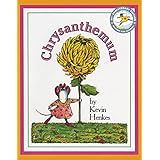 has been publishing since the early 1980s, but his works that are most familiar to me, like
has been publishing since the early 1980s, but his works that are most familiar to me, like 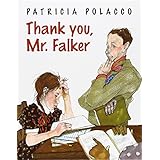 Patricia Polacco: Patricia Polacco’s picture books are a staple of primary school libraries, and she published quite a few during the 1990s (and beyond). Some of her best and most famous works include
Patricia Polacco: Patricia Polacco’s picture books are a staple of primary school libraries, and she published quite a few during the 1990s (and beyond). Some of her best and most famous works include  If we’re talking in terms of popularity, visibility, and continuing impact on culture, I’d have to say J.K. Rowling’s
If we’re talking in terms of popularity, visibility, and continuing impact on culture, I’d have to say J.K. Rowling’s  Jerry Spinelli: Looking at Jerry Spinelli’s extensive publication list from the 1990s, I realize that I was growing up with these books! I turned eleven as this decade began, so I spent my early adolescence picking these up as they filtered into the library. My youthful memories include
Jerry Spinelli: Looking at Jerry Spinelli’s extensive publication list from the 1990s, I realize that I was growing up with these books! I turned eleven as this decade began, so I spent my early adolescence picking these up as they filtered into the library. My youthful memories include 



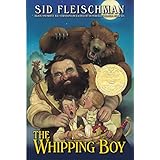






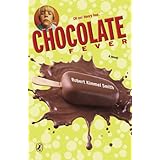

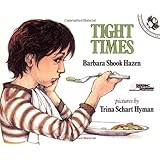
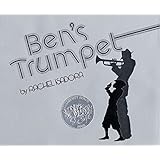


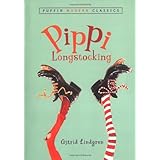



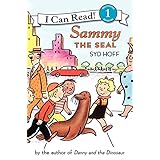








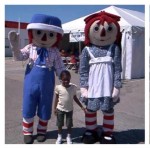
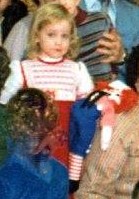
















 Corduroy, by Don Freeman (1968, preschool to early elementary): Corduroy is a toy on the shelf in a big department store, and he has been overlooked for a long time. When a little girl asks to get him and her mother says no because he’s missing a button, Corduroy decides to go in search of his missing button after the store closes for the night. He makes discoveries along the way (“Could this be a mountain?” [on the escalator] “I think I’ve always wanted to climb a mountain!”), but when he pulls a button off a mattress, he knocks over a lamp and gets the attention of the night guard who brings him back downstairs to the toy shop (not realizing Corduroy is the one who made the noise). The next morning, the little girl, Lisa, returns and buys Corduroy with her own money, and she brings him home to her bedroom. When she sews on a new button because she thinks he’ll be more comfortable that way, Corduroy says that he has always wanted a friend, and Lisa responds as though she has heard him speak aloud and gives him a hug.
Corduroy, by Don Freeman (1968, preschool to early elementary): Corduroy is a toy on the shelf in a big department store, and he has been overlooked for a long time. When a little girl asks to get him and her mother says no because he’s missing a button, Corduroy decides to go in search of his missing button after the store closes for the night. He makes discoveries along the way (“Could this be a mountain?” [on the escalator] “I think I’ve always wanted to climb a mountain!”), but when he pulls a button off a mattress, he knocks over a lamp and gets the attention of the night guard who brings him back downstairs to the toy shop (not realizing Corduroy is the one who made the noise). The next morning, the little girl, Lisa, returns and buys Corduroy with her own money, and she brings him home to her bedroom. When she sews on a new button because she thinks he’ll be more comfortable that way, Corduroy says that he has always wanted a friend, and Lisa responds as though she has heard him speak aloud and gives him a hug.






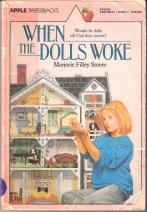

























 written and edited by Penelope York (2015, early to middle elementary): DK can do no wrong when it comes to nonfiction books. Enlarged photographs, interesting information, arrangements by heading (which can be read through or found in the table of contents), and a typical glossary and index all make this book an accessible browse or for simple research. Rich scientific vocabulary means that independent readers will need to use context clues and the glossary for a full understanding, but casual readers will enjoy just looking at the photographs and reading blurbs of information as it interests them.
written and edited by Penelope York (2015, early to middle elementary): DK can do no wrong when it comes to nonfiction books. Enlarged photographs, interesting information, arrangements by heading (which can be read through or found in the table of contents), and a typical glossary and index all make this book an accessible browse or for simple research. Rich scientific vocabulary means that independent readers will need to use context clues and the glossary for a full understanding, but casual readers will enjoy just looking at the photographs and reading blurbs of information as it interests them.
























